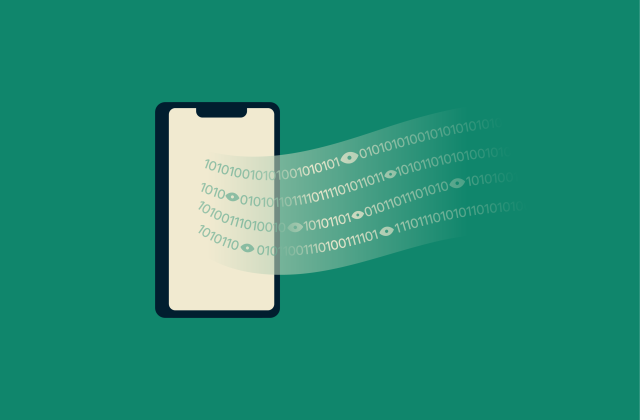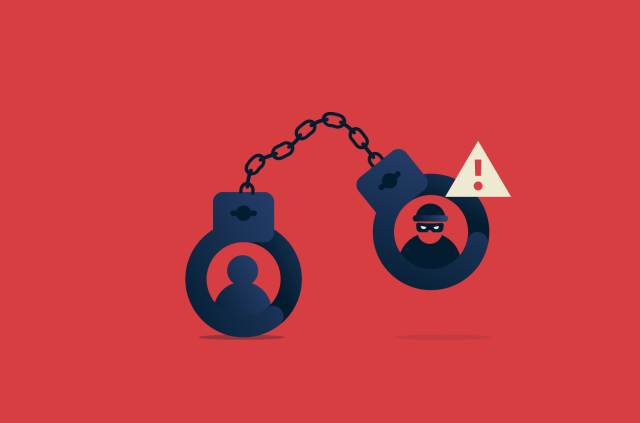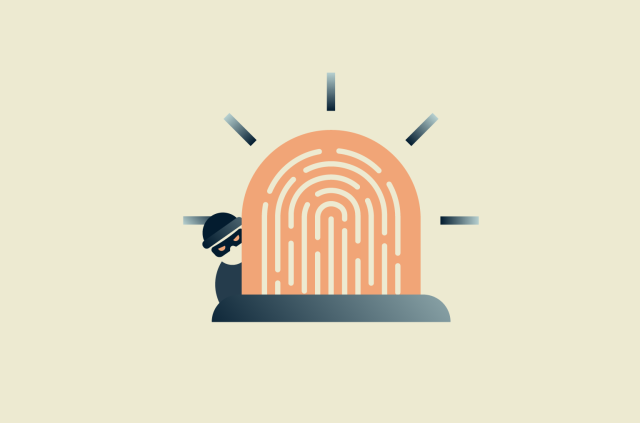Zero-trust data protection explained

For years, security relied on a castle-and-moat approach: keep outsiders out and trust whatever sits inside. Cloud services, remote work, BYOD, and IoT have broken that model. Your data, users, and apps now span multiple clouds, home offices, and regions. The result is a much wider attack surface that a perimeter firewall simply can’t defend.
To deal with this new reality, cybersecurity experts and firms have turned to a new strategy: zero trust.
Note: ExpressVPN is a consumer privacy and security service, not an enterprise framework like zero-trust architecture. We cover this topic because approaches like zero trust are shaping how organizations safeguard data, and they highlight broader trends in digital privacy.
Zero trust 101
 Zero trust starts with a blunt assumption: the network is already hostile. As a result, internal and external traffic are treated the same. Under this approach, admins first validate user identity, device health, and context, then grant only the minimum permissions needed to complete a specific task. After that, any permissions are generally revoked.
Zero trust starts with a blunt assumption: the network is already hostile. As a result, internal and external traffic are treated the same. Under this approach, admins first validate user identity, device health, and context, then grant only the minimum permissions needed to complete a specific task. After that, any permissions are generally revoked.
The goal is to starve attackers of lateral movement and limit the blast radius (the scope of potential damage) when a threat does slip through. This approach is captured in the National Institute of Standards and Technology’s (NIST) definition of zero-trust architecture: “no implicit trust [is] granted to assets or user accounts based solely on their physical or network location.”
For an example, look to Google’s BeyondCorp program. Years ago, Google moved most internal apps from its “trusted” intranet to the open internet behind access proxies. Getting access depends on who you are, the device posture, and policy, not on where you sit on a VLAN.
Zero trust vs. DLP: What’s the difference?
Zero-trust data protection (ZTDP) and data loss prevention (DLP) share a goal of keeping sensitive data safe, but their methods and scope are very different.
How data loss prevention works
Conventional data loss prevention relies on monitoring data movement. DLP tools detect and block the unauthorized movement or exposure of sensitive data across endpoints, networks, and cloud apps. They inspect content, evaluate context, and use policy actions (alert, block, quarantine) with an aim to stop accidental sharing and exfiltration.
Though modern DLP systems can incorporate context-aware scanning and cloud integration, they are still generally reactive, stopping violations as they are spotted.
Why zero trust goes beyond traditional DLP
Zero trust tightens the control plane, restricting who can access data, from which device, under what conditions, and for how long. Monitoring is still a factor, but access is tied to identity, device posture, risk signals, and policy decisions at the moment of access.
The content inspection offered by DLP may fail on new data types, encrypted payloads, or novel exfil paths. Additionally, segmentation and policy engines can shut down lateral movement, preventing potential threats from spreading.
When to use DLP vs. zero-trust architecture
Whether to take a DLP or zero-trust approach is not exactly an either/or choice. Both provide benefits and can be used together. That said, it’s still worth looking into the advantages of each.
DLP is most effective when:
- Organizations must comply with specific data protection regulations that require content-based monitoring.
- Existing security infrastructure is primarily perimeter-based and is functioning adequately.
- The primary concern is preventing accidental data leakage by authorized users.
- Budget constraints limit comprehensive security architecture changes.
- Legacy systems cannot easily integrate with zero-trust principles.
Zero-trust architecture is preferable when:
- Organizations operate in distributed, cloud-first, or hybrid environments.
- Remote work and BYOD policies are standard.
- Advanced persistent threats are the primary concern.
- Regulatory compliance requires strict access controls and continuous monitoring.
- The organization is undergoing digital transformation or infrastructure modernization.
When resources allow, many settings will benefit from taking a combined approach. Under zero-trust architecture, it’s less likely for something to go wrong with regard to data misuse. With DLP working in tandem, if something does go wrong, there’s a greater chance that it will be detected and alerts issued.
Key components of zero-trust data protection
 A strong zero-trust strategy is built on several foundational pillars. Together with these, there are several processes or principles that support the zero-trust formula.
A strong zero-trust strategy is built on several foundational pillars. Together with these, there are several processes or principles that support the zero-trust formula.
Identity verification and access control
Users are authenticated with attribute-based access controls. This can include multi-factor authentication (MFA) to strengthen login security, along with device health checks, the user’s location, the current time, and other factors. The policy engine evaluates all these and grants temporary access based on the individual’s role.
For example, a healthcare worker might only be able to view charts during working hours, when they have signed in with MFA, are using a compliant device, and are at an approved location.
Microsegmentation and least privilege
Perimeter firewalls do little once an attacker lands a valid token. Microsegmentation restricts lateral movement and provides further security by dividing a network into isolated zones, each with its own security rules. The extent to which a threat affecting one area can spread is severely curtailed.
This also relates to the principle of least privilege. When setting up a network, broad access is never assumed. Rather, access between networks is only allowed to the minimum required for a specific task. This applies to both systems and individual users.
Continuous monitoring and behavioral analytics
Zero trust also relies on continuous monitoring of user and device activity, feeding into behavioral analytics systems to spot anomalies. Unusual activity like large data transfers, logins from unexpected locations, or access attempts outside of working hours can trigger automated responses such as session termination or re-authentication. This shortens the time between detection and remediation.
Data-centric security and encryption
Rather than focusing on security through data or content monitoring, zero trust protects the data itself. Admins generally make it a zero-trust policy to encrypt data both while in transit and at rest, ensuring intercepted data remains unreadable without the right keys. Data discovery and classification help security teams locate and prioritize high-value information, applying stricter controls where needed.
Real-time policy enforcement
Dynamic, context-aware policies are enforced in real time. These policies can change automatically based on risk signals such as device compliance status or unusual user behavior. Automated and continuous enforcement makes security decisions without relying solely on manual oversight.
Benefits of zero-trust data protection

1. Stronger compliance with data privacy regulations
Zero-trust frameworks apply granular access controls and continuous monitoring. This can ensure that policies like universal end-to-end encryption are enforced, which may be required under legal frameworks such as GDPR, HIPAA, and PCI DSS. Because access decisions are logged and auditable, organizations can demonstrate control over sensitive data during compliance assessments.
2. Enhanced resilience against internal threats
Many breaches are achieved using valid credentials. Zero trust restricts what a single identity can do. It assumes that insider threats, whether malicious or accidental, are possible. Enforcing least-privilege access, segmenting networks, and re-authenticating requirements all limit the damage a compromised insider account can cause. Additional checks can be required if suspicious activity is detected.
3. Improved cloud and hybrid environment security
Traditional perimeter defenses are far less effective when data spans multiple clouds, SaaS platforms, and on-premises systems. Zero trust applies consistent policies and authentication standards across all environments, securing data regardless of location. This consistency is critical for hybrid workforces and those making use of third-party integrations.
4. Better alignment with remote work strategies
With the shift to remote and hybrid work, employees often connect from personal devices and unmanaged networks. This expands the attack surface. Each major component of zero trust mitigates these risks.
Data classification and encryption matrix
In a zero-trust model, it’s essential to classify data in order to enforce policies and ensure employees follow best practices. A data classification and encryption matrix is a simple tool to help you do this.
Here’s a simple example of what one might look like:
| Data classification level | Description and examples | Access control policy | Minimum encryption standard |
| Level 1: Public | Information that is approved for public consumption (e.g., marketing materials, press releases, public website content, job postings). | No access restrictions. Open to the public. | Encryption in transit (e.g., HTTPS for websites) is standard practice. |
| Level 2:
Private |
Data that is not internal to the company, but shared among a select group of public users (group chats, private messages, hidden profile details, etc.) | Accessible to qualified employees and qualified users. | Encryption in transit (e.g., HTTPS for websites) is standard practice |
| Level 3: Internal | Internal company data shared amongst all users (e.g., internal memos, company-wide Slack channels, etc.). | Accessible to all employees but not to the public or contractors without specific permission. Standard login credentials are required. | Encrypted in transit. Recommended to store encrypted on company servers. |
| Level 4: Restricted | Internal data restricted to specific groups of users (team-based Slack channels, HR records, financial data, etc.) | Access is restricted to specific roles or departments. Requires MFA. Access is regularly reviewed. | Encrypted at rest (256-bit AES) and in transit (TLS 1.2+). |
| Level 5: Confidential | Confidential data shared only on a need-to-know basis (e.g., government secrets, source code, unannounced projects, patient health records, etc.). | Access is granted on a strict, need-to-know basis to specific individuals only. Requires strong MFA for every access attempt. All access is logged and audited. | Encrypted at rest (256-bit AES or stronger) and in transit (TLS 1.3). Additional application-level encryption may be required. |
How industries are using zero-trust data protection
Zero-trust data protection isn’t a one-size-fits-all framework. While its core principles are consistent, each industry and organization must adapt them to address specific risks, compliance mandates, and operational models.
Here’s how four sectors are applying zero-trust data protection in practice:
How financial institutions apply zero-trust principles
Banks, investment firms, and insurance companies handle enormous amounts of sensitive financial data and are a top target for cyberattacks. They use zero trust to protect customer accounts and comply with strict regulations.
For example, a bank might use microsegmentation to isolate its trading platform from its retail banking systems. An employee’s login to one system doesn’t grant them access to the other. Strong identity controls also ensure that only authorized wealth managers can view high-net-worth client portfolios, with every access attempt logged for auditing.
Zero trust in healthcare and regulated industries
The realities of clinical care make for irregular access patterns. Rotating staff, shared workstations, thousands of medical and IoT devices, and shifting schedules all make maintaining compliance and security challenging.
Zero trust accommodates these needs while retaining security by granting access on a case-by-case basis, then logging every decision. On the network side, microsegmentation isolates medical devices from administrative systems.
In practice, this might mean a doctor cannot view the health records of patients not assigned to them. Another benefit might be to make it next to impossible to extract patient data solely based on access to a hospital’s computers.
Government and public sector zero-trust adoption
Public agencies are tasked with keeping services available while maintaining a high level of security. Given that government agencies are a prime target for attackers, there’s been a strong drive to adopt zero-trust standards.
In the U.S., the federal government has mandated that all federal agencies adopt zero-trust architecture. This is being done to secure everything from sensitive intelligence reports to citizens’ data. To this end, an agency might continually check a contractor’s authentication using multiple attributes and only deliver access according to the principle of least privilege.
Use cases for high-growth SaaS companies
Software-as-a-Service (SaaS) companies rely on the cloud, which raises security challenges that traditional DLP may not fully address. Their entire businesses are also built on trust, heightening the need to secure their development environments and protect their customers’ data.
By applying zero-trust principles, a SaaS company can ensure that developers can’t accidentally push code with security flaws into the live production environment. This can also give customers confidence that their data is isolated and protected.
Forward-looking SaaS companies are also preparing for future threats. For example, some are embedding post-quantum cryptography directly into zero-trust network access. This protects user sessions from the threat of future decryption by quantum computers, securing data for the long term.
Readiness checklist: Is ZTDP right for you?
Moving to zero-trust data protection is a significant step. Before you begin, it’s helpful to ask a few questions to make sure your organization is ready.
Key questions to ask before adopting
- What are we trying to protect? Do you have a clear picture of your most sensitive data and critical applications? A full inventory of your data and its locations is essential to get started.
- Who needs access to what? Do you understand the different user roles in your organization and what data they need to perform each task? Knowing this is essential as you prepare to set up policies.
- How strong is our identity and lifecycle management? Are you already using things like Single Sign-On (SSO) and MFA? A solid identity system is the starting point for zero trust.
- What does our network look like? Is your team still mostly in the office, or are they remote? Do you rely heavily on cloud services? Your environment will shape your zero-trust strategy and implementation.
- Do we have leadership support? Adopting zero trust is a strategic initiative, not just an IT project. You’ll need support and budget from leadership to be successful.
Evaluating organizational readiness
Consider your organization’s current state in these key areas:
- Visibility: Can you see who is accessing your network and what they are doing? If your visibility is low, that’s the first thing to work on.
- Technology: Do you have modern tools that can support a zero-trust approach? Integrating older, legacy systems can sometimes pose challenges.
- Processes: Are your security processes well defined? For example, do you have a formal procedure for granting and revoking employee access?
- People: Is your team, in IT and across the company, open to a new way of thinking about security? Change can be hard, so communication and engagement will be key.
Factors based on size, industry, and tech maturity
The ideal zero-trust adoption strategies will vary depending on an organization's attributes. For a small business, the path might begin with basic steps, like enforcing MFA everywhere.
In contrast, large enterprises likely face a more complex implementation and may find it best to start with a pilot project in a single department. For example, try securing remote access for the sales team before rolling it out more broadly.
Your industry also plays a big role. A company in a regulated field like finance or healthcare will naturally focus on compliance, starting by mapping zero-trust controls directly to the specific regulations they must follow.
Meanwhile, a tech-forward company may be positioned to move faster, leveraging modern, cloud-native tools to build a sophisticated zero-trust environment from the ground up.
Mapping zero-trust controls to regulations (GDPR, HIPAA, PCI-DSS)
One of the biggest drivers for adopting zero trust is regulatory compliance. Here’s a table showing how zero-trust architecture can help you meet various common standards:
| Regulation | Regulation requirement | How zero trust helps |
| GDPR Art. 32 | Appropriate technical and organizational measures | Encryption in transit/at rest; microsegmentation to narrow breach scope |
| GDPR Art. 25 | Data protection by design/default | Least privilege and default‑deny policies |
| HIPAA (access control) | Only authorized access to ePHI | Strong auth and contextual policy gating |
| HIPAA (audit controls) | Record and examine activity | Continuous logging and review |
| PCI DSS 7 | Restrict access by business need | Least privilege enforcement |
| PCI DSS 8 | Identify and authenticate users | MFA for admin and user access |
| PCI DSS 1 | Network controls around CDE | Microsegmentation to isolate the CDE |
Challenges and common pitfalls to avoid
1. Underestimating internal resistance
Individuals and organizations are sometimes reluctant to change. Introducing new security steps, even simple ones like MFA, can sometimes be met with pushback if employees feel it slows them down.
How to avoid it: Communication is critical. Explain that adopting zero trust can help protect the company and its data. Start with a pilot group of enthusiastic users to troubleshoot and build support.
2. Failing to map user roles accurately
The principle of least privilege is powerful, but it only works if you know what privileges people actually need for a given task. If policies are too restrictive, productivity could suffer; if they’re too lenient, security gaps open up.
How to avoid it: Don’t make assumptions. Work directly with department managers to understand what applications and data their teams need.
3. Overcomplicating the initial rollout
Zero trust has a lot of moving parts, and it can be tempting to try to do everything at once. This can cause issues and may slow progress.
How to avoid it: Start small. Begin by focusing on one high-risk area, such as securing remote access for all employees.
4. Ignoring the need for continuous adaptation
Zero trust is an ongoing project. Your business will evolve, and new threats will emerge. A zero-trust model that isn’t updated can quickly become ineffective.
How to avoid it: Treat zero trust as a continual effort, not a project with an end date. Regularly review your access policies, user roles, and monitoring logs.
FAQ: Common questions about zero-trust data protection
Is zero trust a replacement for DLP or a complement?
Zero trust can complement DLP. Think of them as partners. Zero trust deals with securing access to data and verifying every user and device; DLP focuses on inspecting data as it leaves to make sure nothing sensitive gets out. When used together, they provide layers of protection. Zero trust reduces the chance of an unauthorized person accessing data, and DLP acts as a final safety net.
How does zero trust protect data in motion vs. at rest?
Zero trust enables organizations to set policies that ensure that data is protected in both states. For example:
- Data in motion (moving across a network) is protected by enforcing encrypted communication channels, like TLS, for every connection. It assumes no network is safe, so all traffic must be secured.
- Data at rest (stored on a server or hard drive) is protected through encryption policies that are often tied to the data’s classification. The most sensitive data gets the strongest encryption.
Does zero trust help with GDPR/CCPA compliance?
Yes. Many of the core principles of zero trust, like least privilege access, strong authentication, and detailed logging, directly reflect the requirements of privacy regulations like GDPR and the CCPA. It gives you the tools and the audit trail to prove you are taking concrete steps to protect personal data.
What’s the first step toward zero-trust data protection?
The best first step for most organizations is to focus on identity. Before you can control access, you need to be confident about who is asking for it. This usually means implementing a strong identity platform with SSO and enforcing MFA across all your critical applications. This single step dramatically improves your security posture and lays the perfect foundation for integrating zero-trust architecture.
Take the first step to protect yourself online. Try ExpressVPN risk-free.
Get ExpressVPN



















